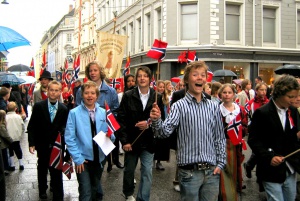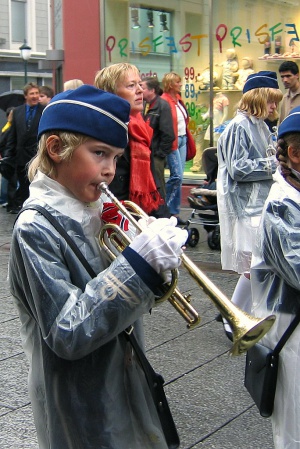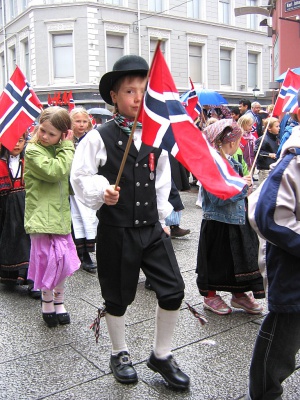17. mai

17. mai (Norwegian for "May 17th") is Norway's constitution day. The day is celebrated with laying wreaths in graveyards early in the morning, singing patriotic songs, and a loud, long and extremely popular children's parade.
The children's parade

The children's parade, barnetoget, is organized in every town, village, and hamlet and consists of children of all ages. Usually schools send children marching and waving flags behind banners displaying school emblems and slogans. The parade begins late in the morning, and crowds gather around to take pictures of schoolchildren interleaved with marching bands playing a variety of patriotic and popular songs.
In larger towns, the children's parade is followed by an adult parade, folketoget, and a parade of graduate students from secondary school, russetoget (see russekort). In smaller towns and villages the three merge into one, with the russ running around throwing russekort at little boys that eagerly gather around. The russ and the boys try to outdo eachother in making noise with rattles and toy trumpets.
The parade in Oslo is legendary for its size and royal participation. The downtown parade can last several hours, although there fortunately are other, shorter parades more suitable for younger children. The parade passes the royal palace, from whose balcony many members of the royal family stand waving at the crowds. In 2006 nine-year-old Marius Borg Høiby was allowed to join them for the first time.
After the parade, children are often taken to public parties where they can play games and adults can listen to speeches and songs. Alternatively, people go to private parties with family and friends. Either way, children are told that that day they get "all the hot dogs and ice cream you can eat".
History

The great poet Henrik Wergeland (1808-1845) is credited with organizing the first children's parade in Eidsvoll in 1820, only a few years after Norway signed its constitution. He is also well known for his National Anthem for Little Boys (Smaaguttenes nationalsang), whose opening lines are familiar to every Norwegian schoolchild:
- We, too, are a nation,
- We little ones, two feet tall.
In Oslo, schoolmaster P. Quam was the first to lead his students into the streets on 17 May 1869. The next year the great author Bjørnstjerne Bjørnson (1832-1910) expanded the celebration to include all of Oslo, and the first citywide children's parade gathered 1200 boys. Girls were not allowed to participate before several years later.
The children's parade has been the defining event of 17. mai ever since. The only exception is the years during World War II; but the celebration on 17 May 1945, only nine days after the Nazi occupation ended, was filled with a new and broader meaning of Norwegian independence.
See also
External links
- Norwegian Constitution Day (English Wikipedia)
- Henrik Wergeland (English Wikipedia)
Sources
- 17. mai (Norwegian Wikipedia)
- Henrik Wergeland (Norwegian Wikipedia)